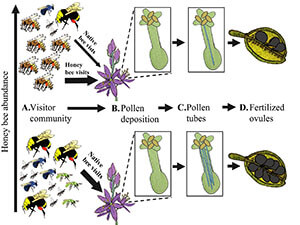
One of the more controversial topics among beekeepers, conservationists, and land managers is the impact that managed honey bees can potentially have on native wild bees and native plants via competition for resources. I decided to wade into the science on this topic in last year’s March and September Notes from the Lab columns [162(3):325-327 and 162(9):1025-1027, respectively]. I highlighted two papers that show how high densities of honey bees near apiaries can cause native wild bees to forage less on certain plant species. In other words, both studies provide indirect evidence for resource competition near apiaries.
The reception to these columns surprised me: Instead of people throwing tomatoes, 100% of people who reached out to me said they enjoyed the articles and wanted to learn more about the topic. So, brave readers of this column, you have spoken (or at least your fellow vocal readers of this column have spoken!) and we’re going to dive even deeper into the topic of competition between managed honey bees and native wild bees. But there’s a twist: This time we’re going to consider impacts of honey bee-native bee competition from a plant’s perspective, not the bees’ perspective.
Are native wild bees better pollinators of a native plant compared to managed honey bees? If so, is there evidence that high honey bee densities near apiaries can displace native wild bees and interfere with plant reproduction? These are the topics for the sixty-third Notes from the Lab, where I summarize “Honey bee introductions displace native bees and decrease pollination of a native wildflower,” written by Maureen Page & Neal Williams and published in the journal Ecology [2023].
For their study, Page & Williams focused on pollination of Camassia quamash, an abundant plant in the western U.S. that’s visited by a wide array of pollinators, including native wild bees and managed honey bees. Camassia benefits from receiving outcrossed pollen via its pollinators (i.e., Camassia plants that receive pollen from a different Camassia plant produce more seeds).
The authors conducted their study on Camassia plants at 15 wildflower fields located at varying distances from four apiaries in the region surrounding Sierraville, California. Ten of the fields were located south of Sierraville. At this location, the authors worked with commercial beekeepers (Randy and Eric Oliver of Golden West Apiaries) to introduce 20 hives to each of three apiaries halfway through the bloom period of Camassia. The remaining five fields were located north of Sierraville near a fourth apiary, which contained ~100 hives and was present throughout the season. Overall, the 15 wildflower fields were located 0-8 km from the four apiaries. In other words, there was a very nice gradient to assess how proximity to apiaries influenced honey bee and native wild bee visitation to Camassia.
At each of the 15 fields, the authors measured bee visitation to Camassia flowers (“visitor community” in Figure 1), pollination (“pollen deposition” and “pollen tubes”), and seed set (“fertilized ovules”). Visitation was assessed by documenting all visitors to Camassia flowers in a timed period. Pollen deposition was assessed by collecting styles from flowers of pre-marked Camassia plants, staining and mounting them on slides, and counting the number of Camassia and “other” pollen grains via microscopy. Pollen tube formation was similarly assessed by revisiting the pre-marked plants 72 hrs after pollen deposition, collecting the style, and staining and counting any pollen tubes that had formed via microscopy. Finally, seed set was assessed by revisiting the pre-marked plants two weeks after pollination and counting fertilized vs. unfertilized ovules.
The last piece of data the authors collected was single-visit effectiveness of each pollinator that visited Camassia. Flowers were bagged to prevent visitation for several days, then bags were removed and a single visit from a pollinator was allowed before flowers were re-bagged to prevent further visitation, and fruits were collected two weeks later. Pollinators were grouped into categories: Apis mellifera, Bombus spp. (bumble bees), Osmia spp. (mason bees), Small dark bees (small sweat bees and mining bees), and Halictus spp. (medium-bodied sweat bees).
So, what did they find? Did honey bee abundance impact native bee visitation to Camassia? Yes. As seen in Figure 2, greater honey bee abundance in meadows resulted in decreased native bee visitation to Camassia flowers. When apiaries were close to fields, honey bees were particularly abundant and native bees visited relatively few Camassia flowers (see blue dots). When apiaries were farther from fields, honey bees were less abundant and native bees visited more flowers (see yellow, orange, and red dots). Overall, there were 0.03 fewer native bee visits to Camassia per hour and 0.04 more honey bee visits per hour for every additional honey bee observed in the fields.
Which bees were effective pollinators of Camassia? On a visit-by-visit basis, Figure 3 shows that bumble bees (Bombus spp.) and mason bees (Osmia spp.) were the most effective pollinators of Camassia. Honey bees were particularly ineffective Camassia pollinators, likely because they almost exclusively collected nectar, sometimes “robbing” plants by visiting from behind petals (Photo 2). Native bees did not rob nectar and often collected pollen. Overall, 77% of native bees contacted stigmas during the single-visit trials compared to only 15% of honey bees.
Interesting. So if honey bees were ineffective Camassia pollinators and they also suppressed native bee visitation, does that mean they interfered with Camassia reproduction? Yes. And the mechanism is simultaneously intuitive and interesting! In meadows with greater honey bee abundance, the probability of detecting nectar in flowers decreased by 3% for every additional honey bee. At the same time, native bee visitation to flowers decreased. In other words, honey bees were tanking up on nectar and making the flowers less attractive to native bees by doing so.
The change in native bee visitation to Camassia flowers had consequences. Less native bee visitation did not result in ….


